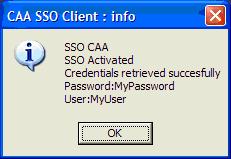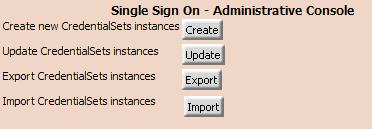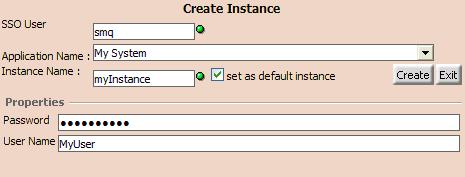3D PLM Enterprise Architecture
|
Single Sign On
|
Using SSO Client
How to leverage SSO capabilities between VPM Navigator and an external
System |
| Use Case |
Abstract
This use case explains how to create a command header to leverage
Single Sign On capabilities. This
command lets you retrieve credentials for a given custom system while you
are already authenticated within VPM Navigator.
|
What You Will Learn With This Use Case
This use case illustrates how to use Single Sign On Client within a command
to retrieve credentials for a custom System. You will learn how to:
- Define credentials for a given System by providing ad-hoc credentialSet
file.
- Define NLS for this credentialSet file to be displayed in the
administration Tool
- Create credentials for your custom System for your users.
- Create a command which is able to retrieve those credentials form VPM
Navigator
You should also read
- How to activate Single Sign On in VPM Navigator from the official
documentation.
[Top]
The CAAPLMSSOClientTest Use Case
CAAPLMSSOClientTest is a use case of the CAASecuritySSOCClient.edu framework that
illustrates PLMSecuritySSOCClient framework capabilities.
[Top]
What Does CAAPLMSSOClientTest Do
CAAPLMSSOClientTest creates a command header whose the
graphic representation is a simple Message Box displaying the retrieved
credentials. The following picture shows the result of the execution of the
command when successful:
Fig.1 The successful command
 |
Here is the sequence diagram of the command. It represents the
whole process to access a custom system from CATIA. the last step (accessMySystemWithCredentials
method ) is not implemented in this use case.
Fig.2 The Sequence Diagram of the command
Fig.3 The Class Diagram of
the CAA Objects
[Top]
How to set up your environment for CAAPLMSSOClientTest
To launch the CAAPLMSSOClientTest use case, you will need to set up the build
time environment for two workspaces and activate SSO both in you VPM Navigator
and in your Application Server. To activate SSO please refer to the official
documentation.
- Server Workspace
This workspace will contain all definitions of the credential required to
authenticate against your custom system. There will be no code in this workspace
only definition files.
- Create a workspace named MySystemServer
- within create a framework MySystemServerSSO
- within this framework create the following directories:
| Windows |
MySystemServer\MySystemServerSSO\CNext\resources\credentials
MySystemServer\MySystemServerSSO\CNext\resources\msgcatalog |
| Unix |
MySystemServer\MySystemServerSSO\CNext\resources\credentials
MySystemServer\MySystemServerSSO\CNext\resources\msgcatalog |
- copy
the following files in the corresponding directories in your runtime view:
| Windows |
MySystemServer\MySystemServerSSO\CNext\resources\credentials\MySystem.credentialSet
MySystemServer\MySystemServerSSO\CNext\resources\msgcatalog\MySystem_credentialSet.CATNls |
| Unix |
MySystemServer/MySystemServerSSO/CNext/resources/credential/MySystem.credentialSet
MySystemServer/MySystemServerSSO/CNext/resources/msgcatalog/MySystem_credentialSet.CATNls |
- Update your runtime view launching mkrtv tool.
Now there is two ways for those definitions to be taken into account by your
Application server.
- You may concatenate your workspace with the install directory of your
SSO Server by restarting WASSetupUI tool or
- You may copy all the content of the runtime view of your workspace in the
runtime view of your installation directory
Then you will have to restart your Application Server.
- VPM Navigator workspace:
This workspace will contain all the client code executed by VPM Navigator.
You will need to
- Copy CAAPLMSSOClientTest.m the module of the CAASecuritySSOCClient.edu
framework
- Build it.
- Update your runtime view launching mkrtv tool.
[Top]
Where to Find the CAAPLMSSOClientTest Code
The CAAAfrEltCountHeader use case is made of several classes mainly located in
modules of the CAAApplicationFrame.edu framework:
| Windows |
InstallRootDirectory\CAASecuritySSOCCLient.edu\ |
| Unix |
InstallRootDirectory/CAASecuritySSOCCLient.edu/ |
where InstallRootDirectory is the directory where the CAA CD-ROM
is installed.
- The CAAPLMSSOClientTest.m module contains
classes to define the the command.
[Top]
Step-by-Step
There are three logical steps in CAAPLMSSOClientTest :
-
Creating a CredentialSet file and its NLS for your custom System
- Creating
Credentials in the SSO Admin Console for your custom system
- Creating the
Class of the command
[Top]
Creating a CredentialSet file and its NLS for your custom System
In this section, we will explain you how
you can leverage SSO capability to enable a command from VPM Navigator to
retrieve your own credentials, for your own System.
There are two steps to be achieved :
-
A .CredentialSets file represents
metadata defining which credentials are required to access a system. Once
credentialSet file is provided it is automatically recognized and usable from
the Single Sign On Administrative console.
A set of Credentials has to be defined
for each system you need to retrieve credentials from the SSO Server. To perform
it you have to deliver an XML file in the runtime view, following this path:
MyWorkspace/MyFramework/CNext/resources/sso/credentials/.
This XML file has to be named with the
name of the system and with ‘credentialSet’ extension.
Here is an example of a CredentialSet
for MySystem : (MySystem.credentialSet)
<?xml version="1.0" encoding="UTF-8"?>
<SSOCredentialSet applicationType=" MySystem
" >
<SSOCredentialDescriptor name="User"
type="String" password="false" hidden="false" />
<SSOCredentialDescriptor name="Password"
type="String" password="true" hidden="false" />
</SSOCredentialSet:SSOCredentialSet> |
|
|
Description of the XML format
The root object is SSOCredentialSet. It describes what are the required credentials to let you authenticate against a custom system. it has one required attribute which is applicationType. This attribute must be valuated with the exact name of the file. It is the ID of your system when you want to retrieve credentials.
the root object can embed any number of SSOCredentialDescriptor element. It represents on credential required to authenticate against your system. It has many attribute :
- name : the name of the credential
- type: the type of the credential (String, int,...)
- password: is the credential is a password and must be displayed with stars from the SSO Administrative Console (can be valuated to true or false)
- hidden: is that credential can be dispalyed within the SSO Administrative Console (can be valuated to true or false)
[Top]
To display NLS names in the Single Sign
On administrative console you may provide an NLS file. The NLS File must be
named as follow: SystemName_credentialSet.CATNls where SystemName is the name in the .credentialSet file. It must be delivered in Workspace/$os/resources/msgCatalog/.
The property applicationType.name must
be set to the NLS name of your System
Then each credential name must follow
this pattern:
SSOCredential.MyCredentialName=”My NLS Message”;
Where MyCredentialName is the
name of the credential given in the .CredentialSet file and My NLS Message is the corresponding NLS message to be displayed.
Here is an example of NLS file:
SSOCredential.Password="Password"; applicationType.name="My System";
SSOCredential.User="User Name"; |
|
|
Now there is two ways for those definitions to be taken into account by your
Application server.
- Regenerate the EAR of your WAS concatenating your w orkspace with your installation when specifying sources in WASSetupUI
or
- You may copy all the content of the runtime view of your workspace in the
runtime view of your installation directory
Then you will have to restart your Application Server.
[Top]
Creating Credentials in the SSO Admin Console for your custom system
Once you
have created your own .credentialSet file you have to administrate those
credentials the same way you did for ENOVIA LCA. It means that you have to
access the Single Sign On administrative console and create credentials instance
for each SSO User you want him to be allowed to access your own System.
Credentials must be created from the SSO Administrative console for a given SSO user and the application MySystem. Go to the URL:
http://host:port/RootURI/html/SSOAdminConsole.
host: is the host name of your WAS
port: is the listening port of the WAS
RootURI: is the rootURI used to install the EAR on the WAS on WASSetupUI tool.
the following panel appears:
Fig4 : The Single Sign On Adminstrative Console

and click on create. the following panel appears:
Fig5 : The create Credentials Panel

Note: smq is the SSO user, it must exist in you User Repository (LDAP if you are using one to secure your WAS)
[Top]
Creating the
Class of the command
Now we will work in the VPM Navigator Workspace.
Creating the header of the command
here is the description of the code of the command which retrieves credentials from the server : TestSSOCAACmd.h
#ifndef TestSSOCAACmd_H
#define TestSSOCAACmd_H
#include "CATStateCommand.h"
#include "CATCommand.h" // for CATStatusChangeRC
#include "CATBoolean.h"
class CATMsgCatalog;
class TestSSOCAACmd : public CATStateCommand
{
public:
//constructor of the command
TestSSOCAACmd ();
virtual ~TestSSOCAACmd (); //destructor of the command
virtual void BuildGraph (); //called when the command is instantiated
private:
//used to retrieve errors when one occurs within the CAASSOClient object
CATUnicodeString HandleError(HRESULT iStatus); r>
//used to Display Msg in a Display Blocked Box
void DisplayMessage(CATUnicodeString &iMessage,int iIsError);
CATMsgCatalog *m_msgCat; //MsgCatalog Object to retrieve NLS msg from TestSSOCAACmd.CATNls int the RTV
};
#endif |
As you can see our inherit from a CATStateCommand. We will build our state graph in the BuildGraph() method. This method is called when the command is instantiated. We also define a method to handle Errors from the CAASSOClient Object with the method HandleError. Finally we define a method to display the final message of the command with DisplayMessage() method. We also have one private member with m_msg to handle NLS messages.
Creating the implementation of the command
here is the description of the code of the command which retrieves credentials from the server : TestSSOCAACmd.cpp
#include "TestSSOCAACmd.h"
#include "CATDlgNotify.h"
#include "CATCreateExternalObject.h"
#include "CATApplicationFrame.h"
#include "CATUnicodeString.h"
#include "CATMsgCatalog.h"
#include "PLMSSOClient.h"
#include "PLMSSOCredential.h"
#include "PLMSSOCredentialSet.h"
CATCreateClass(TestSSOCAACmd);
//-------------------------------------------------------------------------
TestSSOCAACmd::TestSSOCAACmd ():CATStateCommand ("TestSSOCAACmd")
{
//Loading Msg Catalog for this Command
m_msgCat = new CATMsgCatalog();
if (m_msgCat != NULL)m_msgCat->LoadMsgCatalog("TestSSOCAACmd");
}
//-------------------------------------------------------------------------
TestSSOCAACmd::~TestSSOCAACmd()
{
if (m_msgCat != NULL)
{
delete m_msgCat;
m_msgCat=NULL;
}br>}
//-------------------------------------------------------------------------
void TestSSOCAACmd::BuildGraph()
{
CATUnicodeString texte; //text to be display in the Pop-up
HRESULT hr = E_FAIL;
//create the SSO Client Object
PLMSSOClient sso;
CATBoolean activated = FALSE;
// Test if the SSO Has been activated in the RuntimeView
hr = sso.IsSSOActivated(activated);br>
// if it fails display the error message and exits
if (FAILED(hr))
{
texte = HandleError(hr);
DisplayMessage(texte,TRUE);
return;
}
//IF SSO is not activated no need to go further
if (!activated)
{
if (m_msgCat)texte=(m_msgCat->GetCatalogMsg ("NotActivated")).BuildMessage();
DisplayMessage(texte,TRUE);
return;
} //prepare the display of the SSO Activated message
if (m_msgCat)texte = texte +(m_msgCat->GetCatalogMsg ("Activated")).BuildMessage()+"\n";
CATBoolean authenticated=FALSE;
//Test if the End User is Authenticated on the SSO Server
hr = sso.IsAlreadyAuthenticated(authenticated);
//if an error occurs display the error Message and exit
if (FAILED(hr))
{
texte = HandleError(hr);
DisplayMessage(texte,TRUE);
return;
}
//if the user is not authenticated Display the message and exit if (!authenticated)
{
if (m_msgCat)texte = texte +(m_msgCat->GetCatalogMsg ("NotAuhtenticated")).BuildMessage()+"\n";
DisplayMessage(texte,TRUE);
return;
}
//prepare the display of the SSO authenticated message
if (m_msgCat)texte = texte +(m_msgCat->GetCatalogMsg ("Auhtenticated")).BuildMessage()+"\n";
//Try to retrieve the Authenticated User
CATUnicodeString user;
hr = sso.GetAuthenticatedUsername(user);
//If fails display the error and exit
if (FAILED(hr))
{
CATUnicodeString temp;
if (m_msgCat)temp=(m_msgCat->GetCatalogMsg ("ErrorSSOUser")).BuildMessage();
texte =texte + temp+"\n"+HandleError(hr);
DisplayMessage(texte,TRUE);
return;
}
//prepare the display of the retrieved SSO User
if (m_msgCat)texte = texte +(m_msgCat->GetCatalogMsg ("SSOUser")).BuildMessage()+user+"\n";
//Retrieving Credentials for the authenticated user
PLMSSOCredentialSet credentialSet;
hr = sso.GetCredentialSetForApplication("MySystem","",credentialSet);
//if an error occurs display the error Message and exit
if (FAILED(hr))
{
CATUnicodeString tmp;
if (m_msgCat)tmp = (m_msgCat->GetCatalogMsg ("GetCredentialError")).BuildMessage()+"\n";
texte = tmp+HandleError(hr);
DisplayMessage(texte,TRUE);
return;
}
//Prepare the display of the credentials well retrieve status
if (m_msgCat)texte = texte +(m_msgCat->GetCatalogMsg ("CredentialsOK")).BuildMessage()+"\n";
//Do a loop to retrieve and Display all credentials
int size = credentialSet.Size();
for (int k=1;k<=size;k++)
{
CATUnicodeString credentialValue;
CATUnicodeString credentialName;
hr = credentialSet[k].GetCredentialValue(credentialValue);
// if fails while retrieving credential value
if (FAILED(hr))
{
texte =texte + HandleError(hr)+"\n";
DisplayMessage(texte,TRUE);
return;
}
//retrieve the name of the credential
hr = credentialSet[k].GetCredentialName(credentialName);
//if it fails while retrieving credential value
if (FAILED(hr))
{
texte =texte + HandleError(hr)+"\n";
DisplayMessage(texte,TRUE);
return;
}
//prepare the Display of the credential name : value
texte = texte +credentialName+" : "+credentialValue + "\n";
}
//display the info Message
DisplayMessage(texte,FALSE);
}
void TestSSOCAACmd::DisplayMessage(CATUnicodeString& iMsg,int iIsError)
{
CATApplicationFrame* applicationFrame=CATApplicationFrame::GetFrame();
//exits if no applicationFrame found
if (applicationFrame == NULL) return;
CATDlgStyle style =CATDlgNfyOK|CATDlgWndModal;
CATUnicodeString title;
if (iIsError)
{
//retrieve the NLS title of the Display Error Box
if (m_msgCat != NULL)title=(m_msgCat->GetCatalogMsg ("TitleError")).BuildMessage();
//Set the style of the pop-up to an Error Box
style = style |CATDlgNfyError;
}
else
{
//retrieve the NLS title of the Display Info Box
if (m_msgCat != NULL)title=(m_msgCat->GetCatalogMsg ("TitleInfo")).BuildMessage();
}
//create the message Box
CATDlgNotify *notif = new CATDlgNotify(applicationFrame->GetApplicationDocument(),"Notif",style );
//display the Message
notif->DisplayBlocked(iMsg,title);
//ask for destruction of the box
notif->RequestDelayedDestruction();
}
//----------------------------------------------------------------------------
CATUnicodeString TestSSOCAACmd::HandleError(HRESULT iStatus)
{
CATUnicodeString message="";
//Retrieving the Last Error
CATError * pOccurringError = CATError::CATGetLastError(iStatus);
if (pOccurringError != 0)
{
//retrieve the NLS Message of the CATError
message = pOccurringError->GetNLSMessage();
//free the memory of the CATError
pOccurringError->Release();
pOccurringError = NULL;
}
return message;
}
|
The Constructor and destrutors
#include "TestSSOCAACmd.h"
#include "CATDlgNotify.h"
#include "CATCreateExternalObject.h"
#include "CATApplicationFrame.h"
#include "CATUnicodeString.h"
#include "CATMsgCatalog.h"
#include "PLMSSOClient.h"
#include "PLMSSOCredential.h"
#include "PLMSSOCredentialSet.h"
CATCreateClass(TestSSOCAACmd);
//-------------------------------------------------------------------------
TestSSOCAACmd::TestSSOCAACmd ():CATStateCommand ("TestSSOCAACmd")
{
//Loading Msg Catalog for this Command
m_msgCat = new CATMsgCatalog();
if (m_msgCat != NULL)m_msgCat->LoadMsgCatalog("TestSSOCAACmd");
}
//-------------------------------------------------------------------------
TestSSOCAACmd::~TestSSOCAACmd()
{
if (m_msgCat != NULL)
{
delete m_msgCat;
m_msgCat=NULL;
}
}... |
|
here we load abd free the MessageCatalog for our commandThe BuildGraph() Method : getting PLMSSOClient Object and testing environment
... HRESULT hr = E_FAIL;
//create the SSO Client Object
PLMSSOClient sso;
CATBoolean activated = FALSE;
// Test if the SSO Has been activated in the RuntimeView
hr = sso.IsSSOActivated(activated);br>
// if it fails display the error message and exits
if (FAILED(hr))
{
texte = HandleError(hr);
DisplayMessage(texte,TRUE);
return;
}
//IF SSO is not activated no need to go further
if (!activated)
{
if (m_msgCat)texte=(m_msgCat->GetCatalogMsg ("NotActivated")).BuildMessage();
DisplayMessage(texte,TRUE);
return;
} //prepare the display of the SSO Activated message
if (m_msgCat)texte = texte +(m_msgCat->GetCatalogMsg ("Activated")).BuildMessage()+"\n";
... |
|
here we create our PLMSSOClient Object. It is the object which let us retrieve credentials without having to authenticate once more. Now we have that object we have to check if the SSO has been activated with the method IsSSOActivated() . If not there is no need to go further as the SSO will not be able to retrieve credentials. if there is an error or if it is not activated we display the error and return form the BuildGraph() methodThe BuildGraph() Method : Testing if the user is already authenticated
... CATBoolean authenticated=FALSE;
//Test if the End User is Authenticated on the SSO Server
hr = sso.IsAlreadyAuthenticated(authenticated);
//if an error occurs display the error Message and exit
if (FAILED(hr))
{
texte = HandleError(hr);
DisplayMessage(texte,TRUE);
return;
}
//if the user is not authenticated Display the message and exit if (!authenticated)
{
if (m_msgCat)texte = texte +(m_msgCat->GetCatalogMsg ("NotAuhtenticated")).BuildMessage()+"\n";
DisplayMessage(texte,TRUE);
return;
}
//prepare the display of the SSO authenticated message
if (m_msgCat)texte = texte +(m_msgCat->GetCatalogMsg ("Auhtenticated")).BuildMessage()+"\n";... |
|
If the end user has not yet identify itself with the logon panel of ENOVIA the whole command will fail. So we have to check it first. So we can do it using IsAlreadyAuthenticated() method. Once again if false or if the method fails we display the ad-hoc message and exit
The BuildGraph() Method : Retrieving authenticated User name
... //Try to retrieve the Authenticated User
CATUnicodeString user;
hr = sso.GetAuthenticatedUsername(user);
//If fails display the error and exit
if (FAILED(hr))
{
CATUnicodeString temp;
if (m_msgCat)temp=(m_msgCat->GetCatalogMsg ("ErrorSSOUser")).BuildMessage();
texte =texte + temp+"\n"+HandleError(hr);
DisplayMessage(texte,TRUE);
return;
}
//prepare the display of the retrieved SSO User
if (m_msgCat)texte = texte +(m_msgCat->GetCatalogMsg ("SSOUser")).BuildMessage()+user+"\n";
... |
|
We can retrieve the Single Sign On username with the method GetAuthenticatedUseranme().
The BuildGraph() Method : retrieving credentials
... //Retrieving Credentials for the authenticated user
PLMSSOCredentialSet credentialSet;
hr = sso.GetCredentialSetForApplication("MySystem","",credentialSet);
//if an error occurs display the error Message and exit
if (FAILED(hr))
{
CATUnicodeString tmp;
if (m_msgCat)tmp = (m_msgCat->GetCatalogMsg ("GetCredentialError")).BuildMessage()+"\n";
texte = tmp+HandleError(hr);
DisplayMessage(texte,TRUE);
return;
}
//Prepare the display of the credentials well retrieve status
if (m_msgCat)texte = texte +(m_msgCat->GetCatalogMsg ("CredentialsOK")).BuildMessage()+"\n";
... |
|
Here is how to retrieve credentials for the authenticated user form the SSO Server. We use the GetCredentialSetForApplication method to do that. There are two inputs arguments. The first one is the name of the system you are interested on (on our case we want to retrieve credentials for MySystem ). The second argument is the name of the instance of the credentials you want to retrieve for that user. Within the SSO Administrative console you have provided a name of instance while creating credentials for that user and that system. As you can create multiples instance of credentials per user, it is that you name you have to give as a second argument. If you give a blank string (as we did in our example) it returns the default instance. This instance is returned within the PLMSSOCredentialSet object.
The BuildGraph() Method : using the retrieved credentials:
... //Do a loop to retrieve and Display all credentials
int size = credentialSet.Size();
for (int k=1;k<=size;k++)
{
CATUnicodeString credentialValue;
CATUnicodeString credentialName;
hr = credentialSet[k].GetCredentialValue(credentialValue);
// if fails while retrieving credential value
if (FAILED(hr))
{
texte =texte + HandleError(hr)+"\n";
DisplayMessage(texte,TRUE);
return;
}
//retrieve the name of the credential
hr = credentialSet[k].GetCredentialName(credentialName);
//if it fails while retrieving credential value
if (FAILED(hr))
{
texte =texte + HandleError(hr)+"\n";
DisplayMessage(texte,TRUE);
return;
}
//prepare the Display of the credential name : value
texte = texte +credentialName+" : "+credentialValue + "\n";
}
//display the info Message
DisplayMessage(texte,FALSE);
}... |
|
Here is how to retrieve credentials name and value from a PLMSSOCredentialSet object. The PLMSSOCredentialSet can be seen as a container of credentials for a given System and for a given user. So you can get each member as an array item with credentialSet[k]. At that point you have a PLMSSOCredential Object. On that object you can retrieve its name with GetCredentialName() method and its value with GetCredentialValue()
[Top]
Testing the Use Case
[Top]
In Short
This use case has explained how to create credentialSet definition for a custom system. how to create credentials for that system and how to retrieve them from VPM Navigator
[Top]
History
| Version: 1 [Mar 2006] | Document created |
| [Top] |
Copyright © 2006, Dassault Systèmes. All rights reserved.



